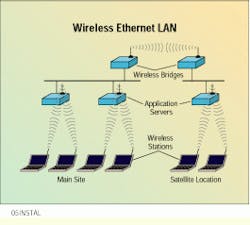Despite the marketing hype, wireless technology won`t replace wired local area networks any time soon. Instead, it offers an affordable complement for difficult-to-reach locations.
John H. Mayer
Is wireless local area network (LAN) technology a cabling contractor`s worst nightmare? It`s easy to see why some might believe so. In theory, at least, the technology offers formidable productivity benefits and savings: employees free to move from location to location without breaking their links to the server; the elimination of cable costs; and the ability to create ad hoc work groups to respond to constantly changing customer needs and a frequently downsized, or reorganized, workforce.
With wireless LAN costs quickly approaching parity with wired solutions, some analysts expect the few hundred thousand wireless LAN users today will grow to over 25 million by the end of the decade.
The reality, of course, is another story. Wireless LAN technology today is still a relatively young technology and suffers many of the familiar pains of infancy. Industry insiders say that the fear that wireless technology will replace wire and cable anytime soon is largely misplaced. Even vendors promoting the technology admit that in its present state, it functions better as a complement to wired solutions than as a competitor.
"Quite frankly, if you`re doing a LAN-to-LAN bridge and you can run fiber, that`s the best thing you can do," concedes Dave Micciche, vice president of sales and marketing at Windata (Littleton, MA), a manufacturer of wireless LANs. "It will be your lowest-cost solution and will give you the best performance and reliability with the smallest number of issues."
So where does wireless technology fit into today`s networking landscape? It frequently shows up in those few cases where it is just not possible to run fiber or coaxial cable. Also, if there is some physical obstacle that makes it too expensive to install cable or where 1.554-megabit-per-second T1 lines can`t offer the performance a particular application requires, wireless may be the answer.
Three competing technologies
At this point the question becomes: Which wireless technology offers the best solution? Three technologies are presently competing for wireless LAN applications--spread-spectrum, narrowband and infrared.
The largest share of the installed base today uses spread- spectrum technology. Developed originally by the military for secure battlefield communications, spread-spectrum modulates a center frequency signal so that it can be spread across the industrial, scientific and medical (ISM) bands of the spectrum designated by the Federal Communications Commission (Washington, DC) in 1985 as available for unlicensed operation of radio devices. While the FCC created three bands--starting at 902 megahertz, 2.4 gigahertz and 5.7 GHz--most of the spread-spectrum LANs presently operate in the 902-MHz and 2.4-GHz bands.
Within the spread-spectrum arena, users can choose from either of two approaches. Direct-sequence spread-spectrum (DSSS) sequentially processes the data stream by chopping up the signal into data packets and spreading it across the spectrum. By spreading the signal over a wider frequency band, this approach avoids an excessive power concentration. Each bit of data is mapped into a pattern by the transmitter. Receivers with a matching encoding scheme can reconstruct the signal by mapping the data back into its original format. Synchronization of the transmitter and receiver is critical to proper operation of a DSSS system.
A second approach, called frequency-hopping spread- spectrum, spreads the signal by randomly hopping from one frequency to another several times a second. To pick up the signal, receivers must match the transmitter`s hop sequence both in frequency and in time.
Both techniques make spread-spectrum not only difficult to intercept, but highly resistant to interference. And since it uses a fairly low frequency, a spread-spectrum LAN tends to offer a range that, in some environments, can extend for miles.
Its primary drawback is bandwidth. Many of the more popular products are limited to 2 Mbits/sec. A few higher-performance products have recently come to market, some offering up to 20 Mbits/sec. But users still pay a stiff premium for this capability.
Narrowband wireless LANs offer another option for high-performance applications. Products like the Altair Plus from Motorola (Arlington Heights, IL) offers data rates of up to 5.7 Mbits/sec by transmitting over a dedicated, licensed bandwidth at 18 GHz.
Unfortunately, that same high-frequency carrier is more subject to absorption or reflection by common building material, and is also more susceptible to multipath distortion as well as interference. As a result, range is limited to about 130 feet.
Infrared technology
The third wireless LAN option is infrared (IR) technology. IR LANs use the same basic technology television viewers use every time they reach for the remote control.
Bandwidth isn`t a problem for IR LANs. Some of the products presently available offer full, wire-like, 16-Mbit/sec Token Ring performance, and for that reason IR is winning adherents, particularly in point-to-point file-transfer applications such as those between computers and printers.
But range and reliability present potential limitations to this technology. IR LANs can`t penetrate opaque barriers, so most IR networks, called directed, must operate on a line-of-sight basis and require that the laser diodes or light-emitting diodes in each system be aimed directly at each other.
Newer, diffuse or reflective IR LANs attempt to overcome this limitation by focusing the light beam on a target mounted on a ceiling or wall; the signal is then reflected around an open area. The diffusion method offers more configuration flexibility, but users pay a bandwidth penalty. Moreover, the performance of IR technologies in general is susceptible to inclement weather, including fog.
While vendors have enhanced the capability of wireless systems tremendously over the last several years, a number of stumbling blocks remain. Potential users are still put off by the diversity of wireless technologies currently available, each with its own set of technical tradeoffs and limitations. Bandwidth, while improving, still doesn`t offer the scalability of wired LANs. Signal reliability is less of a problem than it used to be, but it remains a concern. And despite new technologies featuring encryption, data security remains a major issue, particularly for firms in financial and banking markets.
Standards for wireless technology
On the positive side, standards are finally beginning to emerge for wireless technologies. These standards should go a long way toward eliminating compatibility issues for users. In the IR arena, the Infrared Data Association (Walnut Creek, CA) has recently endorsed a higher-speed, 4-Mbit/sec extension to the established 115-kilobit-per-second standard set in 1994. The extension also guarantees operation up to 3 meters and supports larger, 32-bit packets.
At the same time, the 802.11 committee of the Institute of Electrical and Electronics Engineers Inc. (New York, NY) is progressing toward completion of a wireless-LAN standard for spread-spectrum technology that will play much the same role as the 802.3 standard does for Ethernet and 802.5 standard performs for Token Ring. Once completed, the 802.11 interface will define an over-the-air interface that will facilitate interoperability between wireless-networking products from many different suppliers.
For most users, extending a wired LAN with a wireless solution or using wireless technology as a building-to-building or in-facility bridge is a relatively simple plug-and-play implementation. For example, when the Aladdin Hotel and Casino (Las Vegas, NV) recently decided to upgrade its ability to track customers` spending patterns, a wireless solution turned out to be its best bet. In the highly competitive casino business, frequent customers are often asked to join a players` club and are given a card, similar to a credit card, which they can use to play slot machines or table games. Using the information gathered from the card, casinos often reward their best customers with free drinks, promotions and other incentives to earn return business.
Computer system needed
However, in the past, tracking important guests presented a daunting task at the Aladdin. Employees had to walk around the casino and try to figure out which players should receive complimentary beverages, rooms or meals. What the casino needed was a new computer system that could provide real-time feedback to ensure that the casino made the best use of its promotions. Just as important was a system that could provide better information to technicians maintaining the casino`s 1000 slot machines.
"Typically, slot technicians received calls on a walkie-talkie and went to the machine where the service was required," notes Aladdin`s management information system operations coordinator, Robert Drobish. "They then worked with a dispatcher to run diagnostics and test the machine to make sure it was working."
To improve its productivity, the Aladdin turned to Gaming Systems International (Las Vegas, NV), a systems integrator that packages hardware and software for casinos worldwide. GSI proposed the use of EHT-30 handheld computers from Epson America Inc. (Torrance, CA) fitted with RangeLAN2 wireless LAN adapters from Proxim Inc. (Mountain View, CA). The handheld touchscreen computers access the casino`s PC-based LAN server through a RangeLAN2 access point that bridges the wireless LAN to the wired Ethernet network. Proxim`s RangeLAN2 system uses frequency-hopping spread-spectrum technology running in the 2.4- to 2.4835-GHz band. The wireless system transmits data at 1.6 Mbits/sec.
To keep tabs on the slot machines, GSI inserted a custom- designed board and software into each machine and laid out a 45-topology network using multidrop twisted-pair cable. A server then polled the slots every few hundred microseconds over the Category 5 24-gauge cable.
Typically, GSI`s customers hire a cabling installer to cable the network and lay the homeruns from the carousels that house the slot machines to the central server in the computer room. In the case of the Aladdin, however, a PC-based Novell LAN was already in place, so GSI simply tested the network for cable integrity, installed its network adapters in each slot machine and mounted its tracking software.
GSI then installed Proxim`s RangeLAN2 7500 access points as a wireless bridge to the network. The 7500 operates at the data-link level (layer 2) of the OSI model, providing protocol-independent access into IEEE-802.3 wired Ethernet LANs for mobile computers using the RangeLAN2 PCMCIA LAN adapter card. The unit supplies network interfaces for 10Base-5 (Thick Ethernet) 15-pin attachment unit interfaces, 10Base-2 (Thin Ethernet) BNC connectors and 10Base-T twisted-pair lines. Implementation is literally plug-and-play.
The most complicated part of the installation, according to GSI`s vice president of development, Bob Verhagen, was determining where to position the antenna to ensure coverage of as much of the casino as possible.
With the new system, Aladdin employees on the casino floor can immediately access a database and determine how long a customer has been playing a slot machine or table game and how much he or she has spent. Previously such information was only available to someone operating a PC in the computer room.
The system has also paid off for the Aladdin on the maintenance side. Now, if a slot machine fails, a technician doesn`t have to drop coins in it and then run back to the computer center or call a dispatcher to see what`s wrong. "With the new system, they [technicians] can stand in front of the machine, run the diagnostics and actually see what the computers that are talking to the slot machine are receiving," says Verhagen.
New performance demands
While most wireless systems today interface fairly seamlessly with wired LANs, installers and designers do face a few cabling issues. One of the more interesting is the reliance on coaxial cable in virtually every type of wireless system for antenna feeders as well as to interconnect transmitters, combiners, filters and other components.
As long as the operating frequencies of wireless systems remained low, the use of traditional coaxial cable presented few problems. But as operating frequencies have climbed, so too have the demands placed on those cables. "Wireless communications used to operate at about 150 MHz, and now it`s frequently running at 2 GHz and higher," notes Robert Perelman, manager of commercial sales and marketing at Times Microwave Systems (Wallingford, CT). "As operating frequencies rise, the requirements on coaxial cable becomes tougher in terms of loss and matching of connectors."
Since the attenuation of a cable increases approximately with the square root of frequency, designers have to use larger cables, accept higher loss or turn to higher-performance cables to achieve their signal-loss goals.
As operating frequencies for wireless systems continue to rise and price pressure keeps on building, designers will be looking for new, affordable, low-loss cables to keep costs in line. Manufacturers who can bring to market cabling that meets the performance, flexibility, connector-compatibility and cost requirements of these applications will find a receptive and growing market.
A popular application for wireless local area networks is to link stockbrockers moving about a trading floor.
In this wireless Ethernet local area network, wireless stations can roam seamlessly between access points on either Ethernet segment. Application servers can be connected to either network segment. A pair of wireless bridges links the main site with the satellite location.
Where Wireless Wins Out
While wireless LANs have been used extensively to extend existing wired local area networks (LANs) to mobile platforms, the technology also offers tremendous benefits as a tool to interconnect physically separate LAN segments. Many companies are using spread-spectrum wireless technology for building-to-building links where wired solutions are not practical.
A case in point is Rochester Industrial Controls Inc. (Henrietta, NY). When this contract manufacturer ran out of room in its central manufacturing facilities a few years ago, the company decided to expand its operations to a second location across the street--and approximately 600 feet away. But the firm needed some way to link the wired Ethernet networks in each facility so they could access a common manufacturing resource planning database running on a Macintosh Quadra 650 server at the original site.
Information systems manager Rick Kelley initially looked for a wired solution, but the cabling installer pointed out that running a cable would be prohibitively expensive.
Next, Kelley talked to the local telephone service provider and quickly learned that a T1 line would also be too expensive and Integrated Services Digital Network was not yet available. The only telephone service that was cost-effective at the time didn`t deliver the level of performance Kelley required.
"We started out with a single-pair data circuit that we connected with 14.4-kilobit-per-second modems and the connection was fine," Kelley recalls, "but it was entirely too slow. So we went from a two-wire data line to a four-wire 56-kbit/sec data line, and it was still pretty much unusable for what we needed."
After running across an article on wireless LAN technology, Kelley turned to Rangelink, a family of high-speed wireless data bridges from Proxim Inc. Using spread-spectrum frequency-hopping technology, the wireless units offered a data rate of up to 1.6 Mbits/sec. They also supported virtually any protocol or network operating system that supports Ethernet, including Novell Netware, TCP/IP, Banyan Vines, DECNet, IBM LAN Server and Appletalk.
Kelley handled much of the initial network setup himself, with some help from the local telephone service provider. He ran Class 4 10Base-T cable for the company`s Ethernet LAN. The wired LAN plugs right into the Proxim base station via a standard RJ-45 connection. "It`s amazingly simple," he says. "The Proxim units are simply another node on the network."
Kelley is extremely satisfied with the system`s reliability. With the exception of an occasional glitch related to humidity, the system has operated flawlessly. "One problem we`ve had is trying to shoot through a little section of woods where the moisture in the leaves seems to affect performance," he adds. "But it`s just a matter of resetting and connecting right back up again."
A wireless local area network connected the main manufacturing facility at Rochester Industrial Controls Inc. (Henrietta, NY) with an overflow site across the street. Two Rangelink wireless bridges from Proxim Inc. (Mountain View, CA) formed the wireless link.
John H. Mayer is a freelance writer in Belmont, MA, specializing in computer and telecommunications topics.



